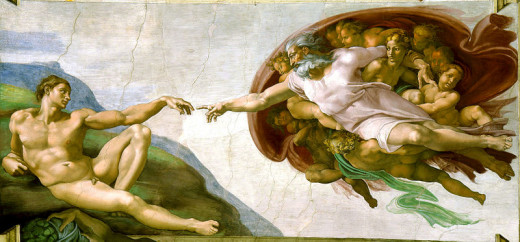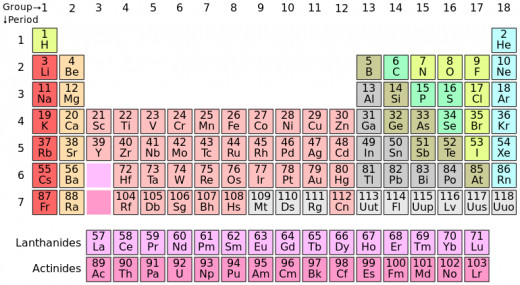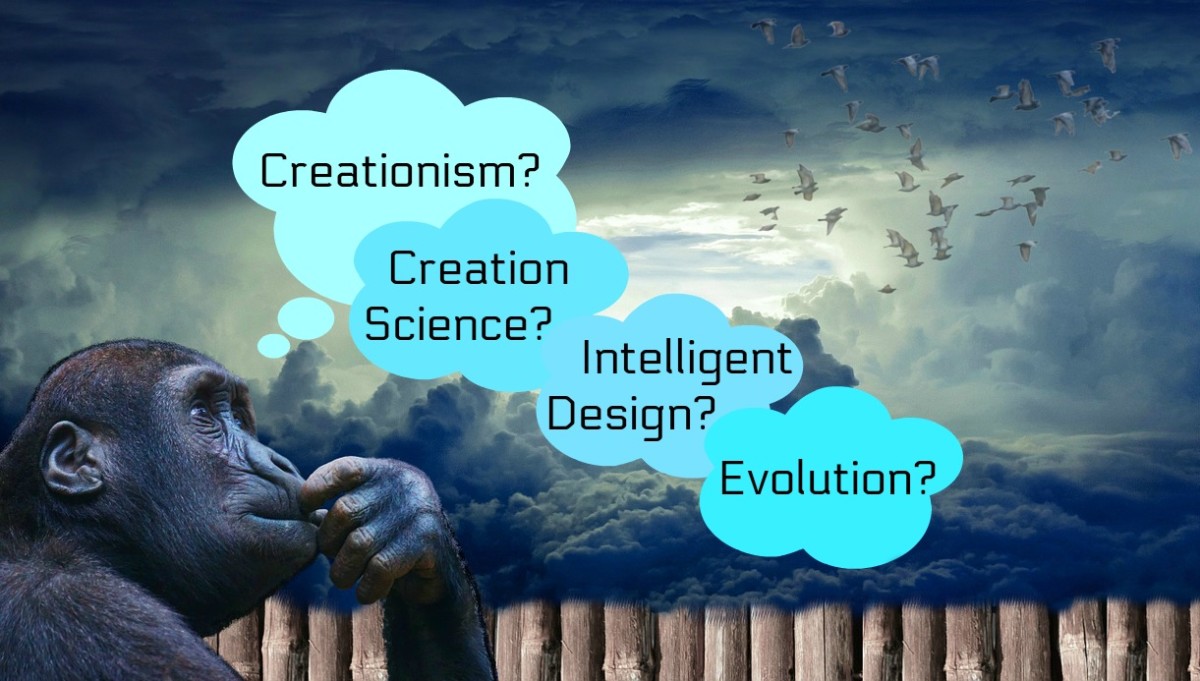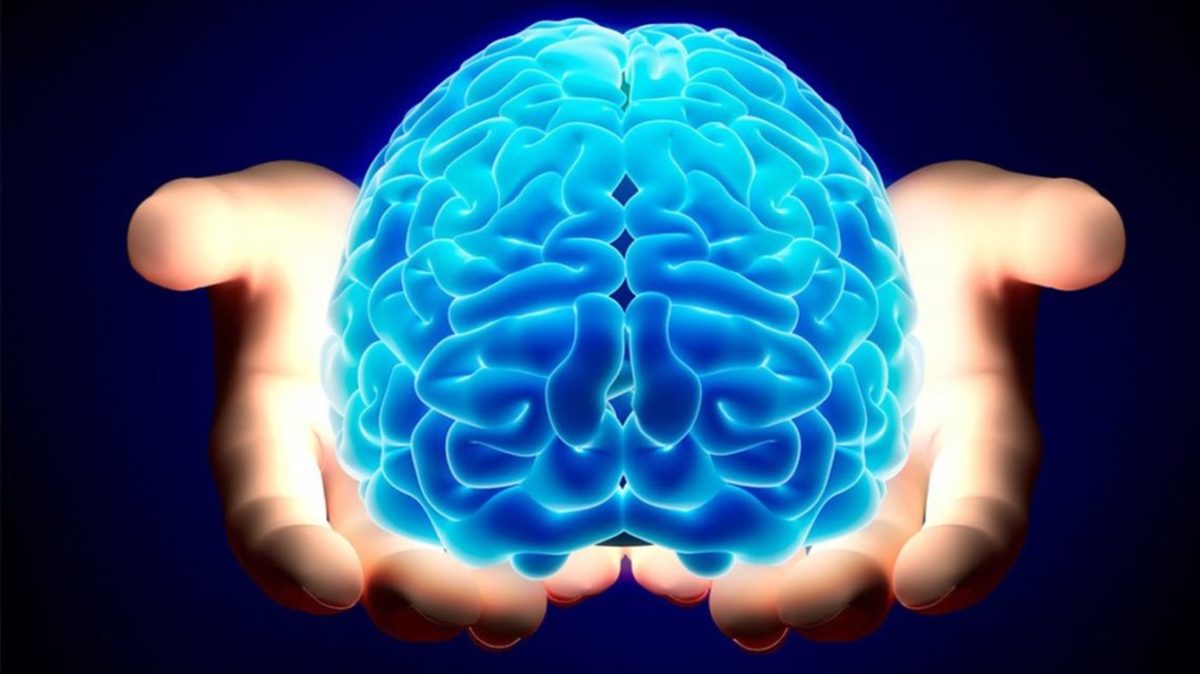Science V. God
The Creation of Adam

Background
Prior to the 17th century, religion was practically unchallenged as a framework for understanding the world, but the scientific revolution was to offer alternative explanations for our existence. In 1632 Italian scientist Galileo Galilei asserted his belief that the Earth revolved around the Sun (a theory first put forward a century earlier); in his book Dialogues on the Two Chief World Systems. The Catholic Church banned it and the Inquisition (a religious tribunal) forced Galileo to denounce his own work as heretical. He was placed under house arrest but during his confinement he wrote Discourses Upon Two New Sciences, which later inspired Isaac Newton to scientific discoveries that further challenged Biblical doctrine.
During the 17th century the emergence of scientific societies such as the Royal Society in Britain and the Academie des Sciences in France provided forums for debate and encouraged the formalisation of the scientific method. The societies also gave science respectability, though it continued to face opposition from the Church.
Isaac Newton’s scientific discoveries were criticised because it was thought that they had demystified the world, but Newton was devoutly religious, and thus was careful not to present science as an alternative to God, and nothing in his work intentionally excluded God from the universe he described. Newton believed that God was the force behind the natural systems his science had sought to explain, with the Universe as a clockwork machine created by God.
Newton’s discoveries caused a revolution in physics and inspired a new intellectual and philosophical movement known as the Enlightenment, whose thinkers based their work on reason and evidence, rather than superstition and accepted beliefs.
Wilberforce On The Attack
'Was it through his grandfather or his grandmother that he claimed his descent from a monkey?'
Bishop Wilberforce, addressing Thomas Huxley at a meeting of The British Association for the Advancement of Science, 1860.
The Great Debate Recreated
The Great Debate
On the 30th June 1860 science clashed with religion on a stage at Oxford University’s Museum Library. Weighing in on one side of the debate were Bishop Samuel Wilberforce and the Anglican Church; on the other was English biologist T.H. Huxley, armed with a copy of On the Origin of Species, published by Charles Darwin, the year before. Darwin’s book, which advocated the theory that all creatures had evolved through natural selection, critically undermined the literal interpretation of the Bible, which held that God created the world, including humans, during a period of six days around 6000 years ago. But religion was more than ready to defend its position. Bishop Wilberforce attacked Huxley over a perceived lack of evidence, while Huxley quipped that he would rather be descended from a monkey than a bishop.
Organising Elements

The Periodic Table
In 1869 Dmitri Mendeleev, a Russian chemist, wrote the name of each chemical element on a card with its chemical properties and atomic weight. Having noticed repeating (or 'periodic') patterns in them, he arranged the cards in a grid according to property (by row) and weight (by column)- the modern Periodic Table has reversed this system. His grid also allowed him to predict the existence and properties of unknown elements, which were not discovered until later.
Huxley's Reasoning
'Irrationally held truths may be more harmful than reasoned errors,'
Thomas H. Huxley in 'The Coming of Age of 'The Origin of Species,'' 1880.
Hard Evidence
This challenge to previously accepted ideas was not a deliberate attack on religion by science, but came simply from the fact that discoveries were being made that were at odds with Christian doctrine. As a Christian himself, Darwin found the situation very difficult and was reluctant to publish his theory for fear of the public’s reaction, ruefully referring to himself as ‘the Devil’s Chaplain.’ Philosophers had been challenging the literal interpretation of the Bible since the Enlightenment, but in the late 18th and early 19th centuries scientific evidence added a new dimension to the debate. From 1785 to 1835 four scientists- James Hutton, Georges Cuvier, William Smith, and Sir Charles Lyell- provided rock and fossil evidence that suggested the Earth was much older than had been thought, casting significant doubt on Biblical chronology and the story of creation, though 19th century was not sufficiently developed to make accurate estimates of the Earth’s age.
The Church was able to cope with these new theories relatively easily. Many Christians were willing to consider Biblical chronology as metaphorical, with its six days of creation being interpreted as epochs or geological time periods. The idea that humans themselves were descended from apes- derided as the ‘monkey theory’- was much harder to accept. Some found a way to reconcile the information with their religious beliefs. The novelist and theologian Charles Kingsley wrote: ‘I have gradually learnt to see that it is just as noble a conception of the Deity to believe that He created primal forms capable of self-development as to believe that He required a fresh intervention to fill the (voids) which He himself had made.’
Geological Evidence

The March Of Science
During the 19th century, the elevation of science from a hobby of the eccentric to a respected and even admired discipline was marked by the use of a new word: its practitioners became known as ‘scientists,’ where previously they had been called ‘natural philosophers.’
Science gained credibility alongside religion, rather than instead of it, and Christianity proved resilient to change. The reduction of the Church’s influence by the state following the French Revolution in 1789 resulted in greater religious freedom throughout Europe, with a move away from state religions towards more numerous denominations. Competition between them resulted in the strengthening of religious loyalties, while a rise in atheism in urban areas led to increased church building in many European cities.
Scientific progress continued, with people experiencing its effects through technology and medical advances. Governments began to address the need for scientific education; research-based university departments were established, as were scientific and technical institutions. As scientific knowledge filtered through society it became more accessible. Despite the fears of the Church, society was not faced with a stark choice between science or God. Instead, these advances led in many cases to the acceptance of both science and belief.
Einstein Weighs In
'Science without religion is lame, religion without science is blind,'
Albert Einstein, Paper for Conference on Science, 1840.
Evolution, Creationism And Humour
The Contemporary Era
Over the last 100 years or so, science has continued its attempts to explain the universe, while the issue of Creationism still causes debate today. In 1927 Georges Lemaitre, a Belgian scientist and Catholic priest, proposed that the universe was created by the explosion of a ‘quantum singularity,’ or ‘big bang’- a state of nothingness, existing outside space and time, containing the potential for everything there is, has been, or will be.
Twenty two years earlier in 1905, Albert Einstein published his special theory of relatively. His theory that speed, mass, space, and time are all relative, and that only the speed of light is constant, replaced the three dimensions of Newtonian physics with a ‘space-time continuum.’
Meanwhile, mainstream Western scientific theories have largely replaced Creationism. However, there is still a vociferous creationist minority, and in modern usage Creationism usually refers to Christian fundamentalists who oppose the teaching of scientific theories such as evolution and the Big Bang.
© 2013 James Kenny








